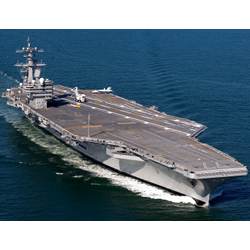
Instead of carrying stockrooms full of spare parts on its ships, only to discover at a crucial moment that the exact part needed was not included, the U.S. Navy aims to use three-dimensional (3D) printers to make replacement parts for ships in its fleet.
Successful implementation of the strategy would eliminate the need for on-board stockpiles of spare parts, reducing costs and increasing efficiency.
Shipbuilder Huntington Ingalls Industries in Newport News, VA, is the only fabricator of nuclear-powered aircraft carriers for the U.S. Navy, as well as the country's largest military shipbuilder. The company's Newport News Shipbuilding (NNS) division is one of just two organizations building nuclear-powered submarines for the Navy (the other being General Dynamics Groton, CT-based Electric Boat division). By partnering with 3D Systems Corp. in Rock Hill, SC, NNS plan to reinvent military shipbuilding.
Ultimately, the collaboration of the two companies is aimed at proving that 3D printing (also known as additive manufacturing) can be used to build warships for the Navy.
"By collaborating with NNS, we aim to streamline the Navy's ship component supply chain with our 3D printers, resulting in both lower costs of operation, as well as higher efficiencies," said Neal Orringer, vice president of Alliances and Partnerships at 3D Systems. "3D printers' additive manufacturing process, combined with our mastery of 3D metal printing, are the key to achieving these goals."
Subtractive manufacturing, such as machining, is akin to sculpting—unwanted parts of a block of material are whittled away (subtracted) until you reach the shape of the desired component; in this way, you get the part you wanted, but at the expense of a wasted pile of sculpted-away material that must either be thrown away or, if metal, smelted into new blocks of raw material—a costly process. In additive metal manufacturing (3D printing), on the other hand, a print head lays down layer after layer of metal, then laser-bonds each layer to the one above it. The result of both processes is the same shaped metal component, but the additive manufacturing process does not waste any material, making it cheaper, more efficient, and faster than the subtractive process.
Industrial-quality 3D printers capable of printing metal materials can tackle even the most sophisticated parts manufacturing. Space science (the U.S. National Aeronautics and Space Administration has tested 3D-printed engine parts for rockets), aeronautics (the aviation industry uses 3D printing to make lightweight, customized parts), and automakers make extensive use of the additive manufacturing process, for design/rapid prototyping, as well as for and parts manufacturing.
"Using 3D Systems ProX DMP 320 additive metal printers for manufacturing U.S. Navy ship components will be a first for us," said Charles Southall, NNS vice president of engineering and design. "We believe this disruptive technology can potentially reinvent the workflow of naval shipbuilding."
To prove the feasibility of building ship replacement parts, and perhaps even production parts in the shipyard, NNS will begin by turning out small components less than a cubic foot in size, such as valves and ducting. Eventually, they hope to build even the most intricate assemblies used in nuclear-powered ships and submarines.
Orringer points out that 3-D printers can generate assemblies that can't be produced in one piece through traditional subtractive manufacturing. "Not only can 3D printers make geometries that can't be made in any other way, but it consolidates the supply chain, thereby shortening design-to-prototype lead times from as much as 24 months to as little as a week, or even just a couple of days."
He explains that with a large-enough 3D printer, "You can fabricate just as many parts at the same time as casting," said Orringer. "You can also use multiple 3D printers simultaneously 24/7 to mass-produce parts just as fast as casting, forging, machining, or welding."
Rather than installing 3D printers on the vessels, which would require them to keep a supply of raw material onboard, plans call for the installation of 3D printers and source materials at U.S naval bases; when a replacement part is needed, the vessel can send the template file for the needed part to the closest port of call, and by the time it arrives, the completed part will be ready for installation.
Makers of 3D printer makers have invented a wide array of powders, resins, and polymers capable of fabricating almost any material. The Navy is interested mostly in titanium, aluminum, and stainless steel, and 3D Systems can supply almost 150 different formulations of these and other metal materials.
All this will not be taking place soon, however, since the Navy has a qualification process for new materials that can take as long as 10 years to complete. Not only do new materials have to be tested for their physical capabilities, such as load bearing, fatigue lifetime, and impact assurance, but they also have to pass numerous nuclear material qualifications (most of which are classified).
Both NNS and 3-D Systems have a great deal of experience working with the U.S. Military. Both have worked with the U.S. Naval Warfare Centers on a wide array of past projects, from exploring new ship shapes to developing new materials to designing ultra-compact one-piece ducting that saves space in aircraft cockpits while providing better cooling for electronics.
R. Colin Johnson is a Kyoto Prize Fellow who has worked as a technology journalist for two decades.



Join the Discussion (0)
Become a Member or Sign In to Post a Comment